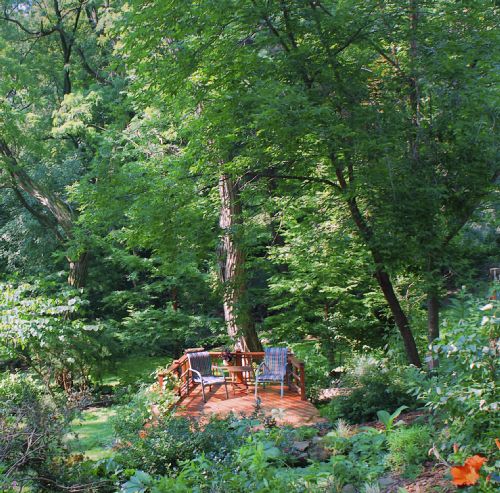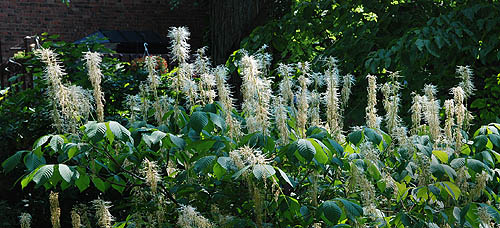
Category Archive: Neighborhood Development
-
North Side Theater is “Spruced Up” — for Hollywood
By Bill Vidonic
PITTSBURGH TRIBUNE-REVIEW
Friday, July 16, 2010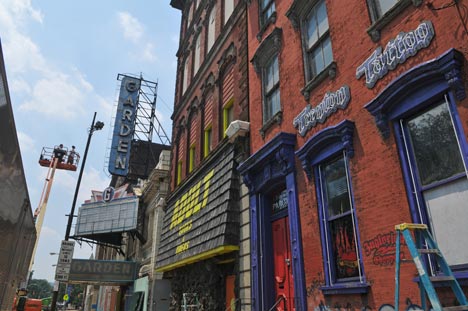
Workers are transforming the old Garden Theater and surrounding buildings in the North Side into a seedy city block of Trenton, N.J., in preparation for filming next week of the movie "One for the Money," starring Katherine Heigl. JC Schisler | Tribune-Review
More than one person passing the former Garden Theater in the North Side did a double-take Thursday, likely wondering whether a decade of working to rid the block of porn establishments suddenly reversed.
Workers replaced the neon on the old X-rated theater’s dilapidated sign. Next door, a painter finished the words “Adult Books and Videos” on the old Apache Bar facade, while others put finishing touches on the Trenton Tattoo parlor, complete with neon lights and spray-painted graffiti.
“(Former) Mayor Murphy took a nap, and here’s what happened,” painter Darien D’Alfonso joked.
Turns out it’s just movie magic.
A production crew for the film “One For the Money” starring Katherine Heigl is transforming the blighted city block into a seedy Trenton, N.J., street; filming starts Wednesday.
That means bringing the exterior of the Garden back to life and creating fake businesses, including a hoagie shop, from vacant storefronts.
“From our perspective, it’s quite ironic, but at the same time it’s exciting,” said Joanna Doven, spokeswoman for Pittsburgh Mayor Luke Ravenstahl. “There are good positive things happening in that area.”
The city spent millions in a lengthy legal battle to clear dilapidated buildings from the section of North Avenue near Allegheny General Hospital before it bought the Garden for $1.1 million in 2007.
“I think it’s great if it’s bringing the city some money,” neighbor Laurie Charlton said about the movie production. “Everybody in the neighborhood is excited about this block coming back to life.”
The Northside Leadership Conference is accepting redevelopment proposals for the Garden and surrounding buildings. A meeting about the redevelopment is scheduled for 6 p.m. Monday in the Children’s Museum.
“It’s a new day there soon,” Doven said.
For a little while longer, though, it will look like the old days.
“I think it’s kinda stupid,” North Side resident William McCue said. “They could have just been here three or four years ago, and everything would have been open for them.”
-
McKeesport Will Demolish 15 Homes
Thursday, July 15, 2010By Candy WoodallMcKeesport’s 7th Ward is getting a face-lift.
Despite a poor economy, McKeesport continues to attract stimulus dollars to improve its neighborhoods.
Using a $100,00 from Allegheny County, Mayor James Brewster said the city will raze another 15 blighted homes along Bailey Avenue, beginning on July 27.
“We’re tearing down a house every four days,” he said.
Mr. Brewster has worked to remove half of McKeesport’s 600 blighted properties since he took office seven years ago, calling them fire and public safety hazards.
Old, boarded-up houses aren’t the only things coming down in the 7th Ward.
Cornell Intermediate School is being demolished to make way for the new Cornell Elementary/Intermediate School being built on the same property as part of McKeesport Area School District’s $46.4 million plan to build two new schools and renovate a third.
The Cornell construction will cost $29 million and help revitalize the neighborhood, according to Superintendent Michael Brinkos.
It is being developed as a green building that will accommodate kindergarten through sixth grade, featuring state-of-the-art facilities and technology, he said.
A public hearing was held Monday in the district’s board room regarding the school’s construction plans.
In addition to removing blight and replacing a 94-year-old school with a new one, City Council also unanimously approved an agreement with McKeesport Neighborhood Initiative to begin $1.4 million of housing development in the Seventh Ward.
“That will complement the new Cornell school,” Mr. Brewster said.
A Weed & Seed initiative will offer help in the 7th Ward, which is a target area along with the 2nd, 3rd and 5th wards.
As a local branch snags funds from Pennsylvania’s recently passed budget, it will work to fulfill the goals of Weed & Seed, a national program that seeks to improve conditions in high-crime neighborhoods.
The city’s Weed & Seed will have $75,000 from the state and $8,330 from the city for an $83,330 budget for the coming year, said Dennis Pittman, city administrator.
The money is earmarked for prevention and intervention programs and pairs with law enforcement efforts.
-
Latrobe Considers Trails Linking to Saint Vincent
Thursday, July 15, 2010By Candy WoodallLatrobe foundation and city leaders are deciding how to establish a trail system that would link the region’s educational, recreational and industrial institutions.
The first step is creating a 2-mile trail from Saint Vincent College in Unity to neighboring Latrobe to provide a connection for the campus’ 2,000 students to the city’s business district.
It’s part of an effort to revitalize the community, according to Ron Weimer, who wears two hats as chairman of the Latrobe Community Revitalization Program and chairman of the Latrobe Planning Commission.
Reaching out to the college has been a goal of the revitalization program for a long time, he said.
Drafts for the trail include utilizing two of the college’s greatest assets — and Westmoreland County’s most famous names — and connecting them to the city’s biggest park.
The school’s Fred M. Rogers Center and Winnie Palmer Nature Reserve would tie in to the proposed trail, and patrons would be able to walk, jog or bike to the 52-acre Legion Keener Park in the heart of Latrobe’s business district. Those on foot or bicycle could then connect to the park trails there.
And those trails may be extending as well. Plans are in the works throughout Latrobe and Derry Township to lay down a trail system that would run along Loyalhanna Creek up to Keystone State Park and the Loyalhanna Gorge.
Early funding — which paid for the Saint Vincent to Latrobe viability study — was provided by the Port of Pittsburgh Commission and the McFeely-Rogers Foundation. The commission awarded a $16,000 grant and the foundation provided $4,000 to finance the $20,000 study conducted by Pittsburgh-based Pashek Associates.
Jim Pashek, president of Pashek, said his firm’s job was to find a feasible way to get from the college to downtown, and that was fraught with some challenges.
The plan features options of how to have the $2.2 million trail — which would largely be funded by foundation grants and private money — bypass the busy Route 981.
One option calls for building a bicycle bridge, and another would use streets parallel to the highway to form the crushed-stone trail, which is designed for traffic by feet, bicycles, strollers and wheelchairs, but not skateboards.
With volunteer work and in-kind services, Mr. Pashek said project costs could be reduced by $482,000. And if the trail parallels the highway, the costs could be reduced by $700,000.
Latrobe’s foundation and commission leaders will have to decide which path the trail should take and will then secure private funding to construct it, Mr. Weimer said.
Mr. Pashek’s firm has worked on dozens of trail projects throughout the region, and he said the popularity is growing.
Mr. Weimer said there’s no question trails are popular in Latrobe.
“All you see are cars around here with racks to haul bikes,” he said.
That popularity inspired the McFeely-Rogers Foundation to support the trail project as it has always had a vested interested in parks and recreation, according to James R. Okonak, executive director at that organization and vice president of the Latrobe Foundation.
“We feel recreation enhances the quality of life,” he said.
“Because of the state of the economy, people can’t always afford to go to the beach for a week or two anymore, so they sort of hunker down and rely on local activities,” he said.
Municipalities are also struggling through the poor financial climate, and the new trail will offer another way to attract a young demographic to Latrobe.
Students will have a choice of restaurants and businesses to go to, as well as a “fantastic arts center,” Mr. Okonak said.
“Anything that helps to connect us with the community of Latrobe to make the city more accessible to our students is all very positive,” said Don Orlando, the college’s spokesman.
Mr. Okonak said he can’t ignore all the Steelers traffic during training camp.
“Maybe the connection would be that fans would come to practice and then bike into the city center,” he said.
His sights are set on even bigger things. He said he sees an opportunity with an abandoned Norfolk Southern rail line parallel to Lincoln Avenue.
That slice of the city can be developed into a dog park and walking/jogging area, he said. City leaders have engaged in talks with the rail company to take over the property.
“And there’s also a thought of taking the trail parallel to the Loyalhanna Creek through Derry to connect to Keystone [State Park] and up to the Loyalhanna Dam,” he said.
Not only are trails a hot topic in Latrobe, they’re gaining popularity all over the state. The Pennsylvania Department of Conservation and Natural Resources has given out “multiple millions of dollars” in grant money to fund trail work, said Chris Novak, press secretary.
The state’s 281 trails span nearly 7,000 miles and provide “a good, family activity that’s not expensive,” she said.
With high gas prices, it’s also being looked at as an alternative to getting around, she said.
It’s also looked at as a way to bring in visitors to an area to spend money.
Several businesses, ranging from ice cream parlors to produce stands to bike shops, are popping up along trails and can be a large part of what spurs the economic benefit, said Mike Kuzemchak, program director at the Ligonier branch of the Western Pennsylvania Conservancy.
Multi-use trails are extremely popular throughout the Laurel Highlands and attract a diversity of people, he said.
That diversity of traffic is good for the ecosystem and is what attracted the Port of Pittsburgh to provide a grant for the Saint Vincent to Latrobe project.
Jim McCarville, executive director of the Port of Pittsburgh, said his organization has a small grant program that awards between $5,000 and $20,000 to make improvements along streams and waterways in the region.
That the Saint Vincent/Latrobe project may spur growth along the Loyalhanna Creek and beyond is very inviting to Mr. McCarville.
The surge in interest in trails, many of which locally are along rivers and streams, proves that people want to reconnect with waterways and see them as an attractive resource.
“Each trail has its own charm and beauty, and linking the college with the downtown area will create a very attractive place for recreation,” he said.
-
Group Asks 1-Year Delay in Mellon Arena Demolition
Thursday, July 15, 2010By Mark Belko, Pittsburgh Post-GazetteA group seeking to save Mellon Arena today urged its owner to delay a proposed demolition for one year.
Rob Pfaffmann, a Downtown architect who leads Reuse the Igloo, asked the city-Allegheny County Sports & Exhibition Authority board to give the group a year to develop an economically viable plan to save the Igloo. The SEA owns the building.
“We do not want to see a white elephant,” he said.
Mr. Pfaffmann said the group also would develop a plan to help the SEA cover the operating costs of the building while a more thorough planning process is undertaken and alternatives are studied.
“We should not rush to judgment on this if we have an economic circumstance that doesn’t demand it,” he said.
Mr. Pfaffmann was among about 10 people to speak at the SEA meeting today in favor of saving the building.
“There’s no do over. Once it’s gone, it’s gone and it will never be back again,” said Nancy Motz Cosnotti. “If the Civic Arena is gone, then part of Pittsburgh will be gone and I don’t want that.”
Reuse the Igloo also would like to see the SEA open the arena’s distinctive dome as a demonstration to see if it still works and to determine the cost of operating it.
SEA Executive Director Mary Conturo said no vote has been scheduled yet on a demolition, favored by the Penguins, Mayor Luke Ravenstahl and county Executive Dan Onorato.
She said the SEA is still in the process of reviewing options through an ongoing historic review process.
Asked whether the SEA would agree to a one-year delay, board chairman Wayne Fontana said the request would be taken under advisement.
“I’m not adverse to anything at this point,” he said.
-
Former Turtle Creek High School’s Architecture, Importance Honored
By Tom Fontaine
PITTSBURGH TRIBUNE-REVIEW
Thursday, July 15, 2010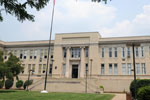
On Saturday, officials will unveil two historical markers that commemorate the former Turtle Creek High School building's architectural significance and role in the community. Officials debated about demolishing the building five years ago, but a group led by former graduates Jill Hinkle, Bob Mock, Jeanne Flaherty and Connie Morenzi led vocal opposition. The Classical Revival-style, cream-colored brick building with stone and terra cotta trim was designed by Pittsburgh architect George Henry Schwan. Jasmine Goldband | Tribune-Review
The former Turtle Creek High School building has gone by several names and narrowly avoided the wrecking ball to remain a community centerpiece since opening during World War I.
On Saturday, officials will unveil two historical markers that commemorate the Monroeville Avenue building’s architectural significance and role in the community.
Although the markers were installed last week, the building was placed on the National Register of Historic Places three years ago and received historic designation last fall from the Pittsburgh History and Landmarks Foundation.
“It basically validates what people in Turtle Creek have felt all along,” said councilwoman Jill Henkel of the markers. Henkel is a 1978 graduate of the former Turtle Creek High School and one of four Turtle Creek natives who led a push to obtain historical designation for the building.
Ground was broken on the $200,000 building in August 1917, and it opened in February 1919 as Union High School, with students from Turtle Creek, Wilmerding, East Pittsburgh and parts of nine other communities, according to documents related to the National Register of Historic Places designation.
The Classical Revival-style, cream-colored brick building with stone and terra cotta trim was designed by Pittsburgh architect George Henry Schwan. He also designed the Twentieth Century Club’s original building in Oakland, the former Oakmont High School and laid out plans for factory-worker developments in Aliquippa and Akron, Ohio.
The building wasn’t home to just high school classes.
Westinghouse employees trained at night in classrooms and vocational shops. Women used school sewing machines after hours to earn money during the Great Depression. And the school’s large lawn provided “the only open green space in the borough,” Henkel said.
“Even today, people are always playing in it,” Henkel said of the lawn. “It’s basically a community park.”
The school would hit a peak enrollment of more than 2,100 students in the 1930s. Also in that decade, after East Pittsburgh and Wilmerding opened their own high schools, Union’s name was changed to Turtle Creek High School. In 1940, the school graduated just 365 students.
When Turtle Creek became part of the newly created Woodland Hills School District in the 1980s, the building became the new district’s East Junior High. Officials debated about demolishing the building five years ago, but a group led by former graduates Hinkle, Bob Mock, Jeanne Flaherty and Connie Morenzi led vocal opposition.
Ultimately, the district moved East Junior High students elsewhere and mothballed the Turtle Creek building for the 2008-09 school year; it reopened last August, housing the district’s new Woodland Hills Academy for elementary students.
“I would have laid down in front of the bulldozer if they tried to tear down the building,” said Mock, a 1968 graduate.
The unveiling of the marker, part of Turtle Creek Community Days festivities, begins at 7:30 p.m. on Saturday at 126 Monroeville Ave.
-
Steel Valley Agency Eyes Old Gym For After-School Use
By Chris Ramirez
PITTSBURGH TRIBUNE-REVIEW
Thursday, July 15, 2010
Christian Michaels, 8, shoots hoops during a summer camp at Homestead United Prebyterian Church in Homestead. The camp is organized by the Methodist Union of Social Agencies, or MUSA, which wants to run after school programs for middle school children in the Steel Valley Council of Governments' gymnasium. James Knox | Tribune-Review
Decades ago, the old gymnasium attached to the Steel Valley Council of Governments building was the place to go for pick-up basketball games and summer youth camps.
Not so much now.
Amid the walls, streaked with unsightly graffiti and time-yellowed pin-ups, the Rev. Jim Cannistraci sees potential.
He and a small-but-growing band of community leaders are trying to generate local support — and money — to convert the aging gym into a state-licensed center for programs that cater to middle school children.
“This isn’t my dream. It’s the dream of the community,” said Cannistraci, executive director of the Methodist Union of Social Agencies. “People want this and people need this.”
They envision starting a program that would see to the needs of children from West Homestead, Munhall and Homestead, where half the population is black and one in four residents lives below the poverty line, according to U.S. Census figures.
Among services Cannistraci hopes can be offered at the center would be help with homework, access to computer labs and career exploration sessions. The Methodist Union wants the program to start Sept. 1, but needs to raise more than $100,000 before then for improvements to the gym.
Cannistraci envisions the program serving about 50 students by the end of the upcoming school year, but expects it eventually to cater to as many as 125.
“A lot of kids get out of school at three, but their parents are still at work. That’s also when they face a lot of temptation to do things that can get them in trouble,” said Douglas R. Spencer, executive director for the Allegheny Children’s Initiative, a South Side nonprofit pushing for the change. “That time needs to be occupied with structured activities.”

RaVyn Wright, 9, (left) and Edaiza Sands, 10, have fun playing computer games during a summer camp at Homestead United Prebyterian Church in Homestead. The camp is organized by the Methodist Union of Social Agencies, or MUSA, which is looking to generate funds to renovate the former gym and building that belonged to Homestead High School for an after school program that would see to the needs of children from West Homestead, Munhall and Homestead.
Homestead does not have a YMCA, Boys and Girls clubs or a private community center for middle school students to go to in the afternoon as neighboring communities do. A local chapter of the Salvation Army offers a free after-school program for children ages 6 to 12, and Methodist Union of Social Agencies holds after-school programs at Barrett and Park elementary schools.
For more than 80 years, the Methodist Union has aided families and children of the Mon and Steel valleys. The past three decades have been among the most challenging as the two areas struggle to find solid financial footing in the wake of the steel industry’s collapse.
Last week, the Steel Valley Council of Governments, which owns the gym, examined the prospect of an after-school program at a public meeting.
The gym for years belonged to Homestead High School and often was the backdrop to basketball games and large student assemblies. But that changed in 1979 when the Homestead school district merged with West Homestead and Munhall to form the Steel Valley School District.
The Allegheny Works program, which offered job-training programs and operated out of the old high school as the collapse of the steel industry began in the 1980s, used the gym for workshops for many years. These days, however, the gym is used only sparingly.
The Steel Valley Council of Governments says the gym is habitable, but $750,000 is needed to make it usable for a variety of purposes in addition to the after-school program.
-
Greening the South Side: Residents Plant Nearly Two Dozen Street Trees
Wednesday, January 13, 2010
South Side will begin to look greener in the spring thanks to Kim Collins.
Back in March, she and a friend were talking over wine one night, trying to think of something they could do in their community. “And we came up with trees,” says Collins. “I live on Wharton Street and there was, like, one tree on my block.”
Collins, who is the owner and creative director of South Side-based graphic design firm Blue Tomato, worked to create the South Side Pittsburgh Tree Project with the help of neighbors and nearly 45 volunteers.
In October, they planted 21 trees ranging from maples to lilacs on the 1900 block of Wharton Street.
To start the project, Collins researched and found the TreeVitalize program, a partnership between five organizations including the city, county and state and two nonprofits, including the Western Pennsylvania Conservancy. The goal of the program, according to its website, is to “plant 20,000 trees by 2012 throughout the Pittsburgh region in order to improve quality of life and the environment.”
Once assisted by TreeVitalize, Collins and other leaders went door-to-door asking residents if they would water and take care of trees if the South Side Pittsburgh Tree Project took care of planting. Twenty-one residents agreed to this arrangement for the first planting.
Riverset Credit Union aided the project by paying for the website and marketing, as well as a banner on Sarah and 11th Streets that asks, “Want A Free Tree?”
The South Side Pittsburgh Tree Project wants add at least 300 to 400 more trees in the South Side over the next four years.
Currently, 4,500 trees have been planted in Allegheny County through TreeVitalize.
Sign up to receive Pop City each week.
Writer: Pop City Staff
Source: Kim Collins, South Side Pittsburgh Tree ProjectImage courtesy of South Side Pittsburgh Tree Project
-
Mount Lebanon Gardener Turns Destruction into Opportunity
Saturday, July 10, 2010By Kevin Kirkland, Pittsburgh Post-Gazette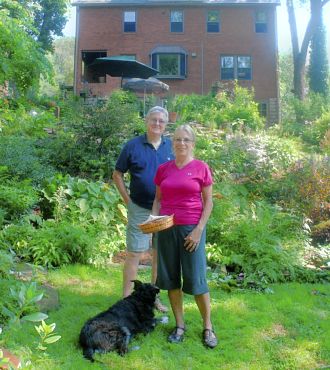
Larry Roberts / Post-Gazette Wes and Nancy Smith will open their garden for the Mt. Lebanon Library's 20th Anniversary Garden Tour.
In more than 25 years of Pittsburgh gardening, Nancy Smith has tested, sometimes fooled and been humbled by Mother Nature.
She has succeeded with plants that supposedly need more sunlight or aren’t supposed to survive our winters. And she has lost perfectly suitable plants and trees to beastly weather, critters big and small and for no earthly reason at all. She tries to see major disasters like falling trees as an opportunity for change.
“It opens something up,” she says.
But the past five months have tested even the most hopeful gardener’s patience.
February’s snowmageddon brought down three large junipers, a chamaecyparis and a Leyland cypress. A great blue heron ate one large koi and more than half of the dozen goldfish in two ponds, and birds and rodents teamed up to steal her entire crop of strawberries. Then, recent high winds brought a neighbor’s 80-foot-tall black locust tree crashing down on a bed between the two ponds.
Despite it all, Mrs. Smith will have her garden looking great for Sunday’s Mt. Lebanon Library Garden Tour. Hers and six other gardens will be open from noon to 5 p.m. You can see more of her handiwork today, when the library holds its garden party in the courtyard that Mrs. Smith and 11 other volunteers have created over the past 10 years.
Everywhere she gardens, Mrs. Smith tries to keep a simple motto in mind:
Destruction is an opportunity for change.
Growing up near Baltimore, she failed in her first attempt at a garden at age 9. She had better luck shortly after she married Wes Smith, another Maryland native. Her parents brought lots of plants from their yard to the rental property the newlyweds shared. They moved to Mt. Lebanon in 1983 and volunteering at the library garden led to classes at what is now Phipps Garden Center. She became a master gardener in 1987 and was one of the leaders in designing and planting the library’s courtyard garden in 2000-01.
Meanwhile, Mrs. Smith was transforming her front and back yard, which once held mostly grass and a pedestrian collection of yews, forsythia, pachysandra and a few large spruce, locust and maple trees. The front still has a little grass nearly hidden by beds packed with interesting cultivars of phlox, sedum, ligularia, boxwood, hydrangea, yellow-leafed caryopteris and other perennials and shrubs. A fast-growing curly willow and red maple provide some shade.
The backyard originally held a concrete patio leading to a grassy hillside. But it soon changed.
“Every year we add something,” Mrs. Smith said.
She adds the plants (she says she’s a reformed “plant hog”) and her husband adds hardscape.
“I build or haul or cut grass,” he said modestly.
One year, Mr. Smith and his two sons-in-law replaced the concrete patio with one made of paver bricks laid in a herringbone pattern. Mrs. Smith created perennial beds around the old brick walls and grill, featuring larkspur, catchfly (Silene armeria), amsonia, New England asters, Joe Pye weed, cleome and an arum with exotic long leaves and giraffe-like spots on its thick stem.
When a willow fell nearby, Mrs, Smith asked her husband to build a pond near the stump. The next year he built a lower pond and linked them with a waterfall. The year the garden was on the Pittsburgh Botanic Garden Tour, he built a deck near the lower pond. He also built a cold frame and all the paths in the backyard.
With each piece of hardscape, Mrs. Smith creates adjoining beds. And as trees or limbs fall, she adds interesting shrubs and trees. She’s planted two metasequoias, a paperbark maple, redbud, fernleaf buckthorn, Carolina silverbell, Virginia juniper, ‘Diablo’ ninebark and a bottlebrush buckeye (Aesculus parviflora) that is just done blooming.
A shady bed near the bottom of the hill features Lenten rose, hostas, goatsbeard, ferns, variegated Solomon’s seal and Allegheny spurge, our native pachysandra.
“I like to do a lot of natives,” Mrs. Smith says, but her garden is not limited to them.
Her advice to gardeners who are just starting is simple: Take classes and talk to other gardeners about plants that do well here. And don’t overdo it.
“You can’t handle more than one new garden per year,” she said. “Otherwise, it’s a full-time job.”
Mt. Lebanon Library’s 20th anniversary Garden Tour runs from noon to 5 p.m. Sunday. The library will have a plant sale and free consultations with Penn State Master Gardeners and a member of the Pittsburgh Rose Society. Tickets are $12 in advance and $15 on tour day at the library. A pre-tour Garden Party will be held from 6 to 8 p.m. today in the library garden courtyard. Tickets are $25 per person and available at the door.


